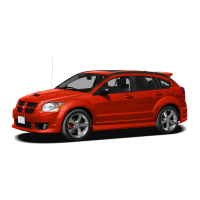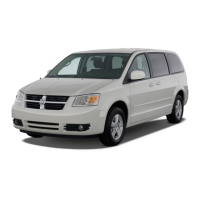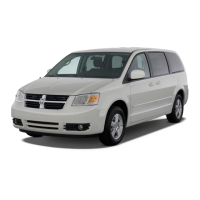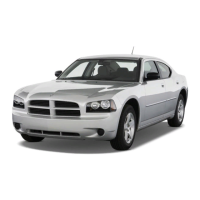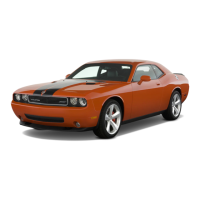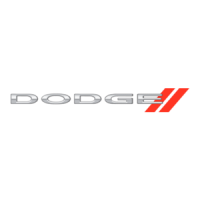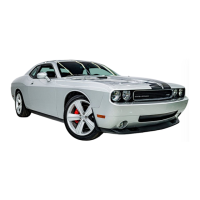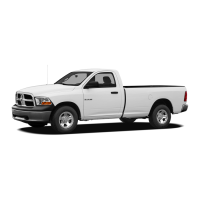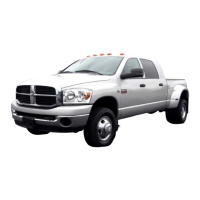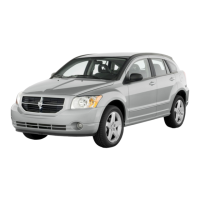
Do you have a question about the Dodge 2009 Caliber and is the answer not in the manual?
| Brand | Dodge |
|---|---|
| Model | 2009 Caliber |
| Category | Automobile |
| Language | English |
Provides guidance on navigating the manual, including using the table of contents and index for information.
Highlights warnings against operating procedures that could result in accidents or injury, and cautions for vehicle damage.
Explains the location of the VIN on the instrument panel, visible through the windshield, and its appearance on registration.
Warns that modifications could affect roadworthiness, safety, and lead to injury or death.
Details about obtaining and using vehicle key code numbers for duplicate keys and ignition key removal.
Explains the Sentry Key system, its function in preventing unauthorized vehicle operation by disabling the engine.
Describes the Vehicle Security Alarm system, its monitoring functions, and how it alerts unauthorized operation.
Details the system allowing remote locking/unlocking of doors and liftgate, and activating the Panic Alarm.
Covers manual and power door lock operations, including child-protection systems and automatic locking features.
Explains the operation of power window switches, including the Auto Down feature and lockout switch.
Provides instructions on how to lock, unlock, and open or close the liftgate using the key or remote transmitter.
Details the importance and proper use of seat belts, including lap/shoulder belts and child restraint systems.
Provides guidance on selecting and using infant and child restraints, including rearward-facing and forward-facing seats.
Offers recommendations for breaking in the engine during the initial miles for optimal performance and durability.
Offers general safety advice for vehicle operation, including passenger transport and hazard awareness.
Warns about the dangers of exhaust gases, including carbon monoxide, and provides safety precautions.
Details safety checks for seat belts and the airbag warning light, including defroster operation.
Covers safety checks for tires, including wear, pressure, and general information.
Provides information on inside day/night mirrors, automatic dimming, outside mirrors, vanity mirrors, and sun visor features.
Explains the features of the uconnect phone system, including operation, voice commands, and phone pairing.
Details the voice recognition system operation, commands, voice training, and performance optimization.
Covers front seat adjustment, manual seat height and lumbar adjustment, seatback recline, and head restraints.
Explains the operation of heated front seats, including heat settings and safety warnings.
Provides instructions on how to fold the front passenger seat flat for increased cargo space.
Details how to fold the rear seatback forward to create additional storage area.
Explains how to adjust the rear seatback for additional comfort by releasing the seatback latch.
Provides instructions on how to release the hood latches and open or close the hood safely.
Covers the multifunction lever for lights, headlight and parking light operation, and lights-on reminders.
Explains how to activate front fog lights and their operating conditions with headlights.
Describes the operation of turn signals and how to signal a lane change.
Explains the function and operation of Daytime Running Lights (DRL) and when they turn off.
Covers windshield wiper operation, intermittent wiper system, and windshield washer usage.
Details how to activate a single wiper wipe for clearing road mist or spray.
Provides instructions on how to adjust the tilt steering column for driver comfort and safety.
Explains the operation of the Electronic Speed Control system, including activation, deactivation, and speed settings.
Covers the HomeLink system for operating garage doors and other devices, including programming.
Details the operation of the power sunroof, including opening, closing, pinch protection, and venting.
Describes the 12-volt power outlet for powering electronic devices and provides safety cautions.
Explains the 115-volt AC power inverter for powering low power devices and its limitations.
Details the location and number of cupholders in the vehicle.
Describes the sliding armrest, flip pocket for phone/MP3 player, and console bin storage.
Covers cargo light, removable flashlight, cargo cover, removable load floor, and tie-down loops.
Provides information on the rear window wiper/washer and rear window defroster operation.
Explains the function of the cooled beverage storage bin and glove compartment.
Provides an overview of the instrument panel features, including outlets, demisters, cluster, and radio.
Details various instrument cluster indicators, including fuel gauge, speedometer, tachometer, and warning lights.
Explains the EVIC system, its functions, messages, and how to reset displays.
Covers operating instructions for the REQ radio, including radio mode, CD/MP3 playback, and settings.
Details operating instructions for the RES radio, including radio mode, CD/MP3 playback, and clock settings.
Explains operating instructions for the RES/RSC radio, including radio, CD, and Sirius modes.
Provides essential steps for starting the vehicle, including seat adjustment, mirrors, seat belts, and key operation.
Covers starting procedures for manual transmission, recommended shift speeds, and downshifting.
Details starting procedures for automatic transmission, interlock systems, and gear ranges.
Explains the driver-interactive transmission system, its operation, and general information.
Offers advice on acceleration, traction, and precautions for driving on wet or slushy roads.
Provides caution and warning guidelines for driving through shallow or flowing water.
Describes the power steering system, its operation, and fluid level checks.
Explains the operation and function of the parking brake and brake system.
Details the ABS function, its warning light, and how it enhances vehicle stability during braking.
Covers ABS, Brake Assist (BAS), Traction Control (TCS), and Electronic Stability Program (ESP).
Provides information on tire markings, identification numbers, loading, and pressure.
Specifies the recommended gasoline octane rating and cautions against using improper fuel blends.
Warns about the dangers of carbon monoxide in exhaust gases and provides safety precautions.
Explains how to determine correct load limits, including occupant and cargo weight.
Provides safety tips and information on towing limits, definitions, and requirements for safe trailer towing.
Explains how to use the hazard warning flashers to alert traffic in an emergency situation.
Provides actions to take to reduce overheating potential, including slowing down and managing the air conditioning.
Describes what to do if the automatic transaxle oil becomes too hot during driving or towing.
Covers safety warnings for jacking, tire changing, jack location, spare tire stowage, and preparation.
Provides step-by-step instructions and warnings for jump-starting a vehicle using booster cables.
Offers advice on how to free a vehicle stuck in mud, sand, or snow using a rocking motion.
Details towing procedures for disabled vehicles, including with or without the ignition key.
Identifies components in the engine compartment for the 2.0L engine, including fluid reservoirs and battery.
Identifies components in the engine compartment for the 2.4L engine, including fluids, battery, and air cleaner.
Explains the OBD II system's role in monitoring vehicle performance, emissions, and the Malfunction Indicator Light (MIL).
Covers requirements for emissions inspections and how to check if the OBD II system is ready for testing.
Recommends using genuine MOPAR parts for maintenance and repairs to ensure performance and warranty coverage.
Highlights the benefits of using authorized dealers for expert service, special tools, and qualified technicians.
Details required maintenance services and items that should be inspected if a malfunction is observed.
Covers checking the engine oil level, change intervals, and selecting the correct engine oil.
Specifies that the oil filter should be replaced at every oil change and recommends using high-quality filters.
Recommends referring to the maintenance schedule for the filter interval and provides warnings about removal.
Describes the maintenance-free battery, its sealed top, and safety precautions when handling.
Advises on checking and servicing the air conditioner annually, including condenser fins and performance test.
Provides guidance on lubricating locks, pivot points, hinges, and external lock cylinders for proper operation.
Explains how to clean wiper blades and windshield to reduce streaking and smearing.
Details the location of the washer fluid reservoir and how to fill it with the correct solvent.
Emphasizes the importance of a maintained exhaust system for preventing carbon monoxide entry.
Covers coolant checks, drain/flush/refill procedures, and coolant selection for optimal performance.
Recommends periodic inspection of brake system components for assured performance and safety.
Details lubricant selection, fluid level checks, and fluid/filter changes for the automatic transaxle.
Covers lubricant selection and fluid level checks for the manual transaxle.
Provides recommendations for vehicle body care, washing, and protection from corrosion.
Details the Integrated Power Module (IPM) which contains cartridge and mini-fuses for various vehicle systems.
Offers steps to preserve the vehicle's battery if it will not be used for more than 21 days.
Lists interior light bulb numbers and specifies that aluminum base bulbs are not approved for replacement.
Provides instructions for replacing headlights, fog lights, and other exterior bulbs.
Highlights scheduled maintenance for emissions control systems to ensure proper function and reliability.
Details the oil change indicator system reminders and recommended service intervals for various mileages.
Lists required maintenance items and intervals for different mileage and time periods.
Outlines maintenance tasks for the 6,000-mile or 6-month service interval, including oil change and tire rotation.
Details maintenance tasks for the 12,000-mile or 12-month service, including inspections and filter replacement.
Outlines maintenance for the 18,000-mile or 18-month service, including oil change, tire rotation, and spark plugs.
Details maintenance for the 24,000-mile or 24-month service, including inspections and filter replacements.
Lists maintenance tasks for the 30,000-mile or 30-month service, including spark plugs and parking brake adjustment.
Outlines maintenance for the 36,000-mile or 36-month service, including brake linings and air conditioning filter.
Details maintenance for the 42,000-mile or 42-month service, including oil change and tire rotation.
Lists maintenance for the 48,000-mile or 48-month service, including CV joints and exhaust system inspection.
Outlines maintenance for the 54,000-mile or 54-month service, including oil change and tire rotation.
Details maintenance for the 60,000-mile or 60-month service, including spark plugs and coolant flush.
Lists maintenance tasks for the 66,000-mile or 66-month service, including oil change and tire rotation.
Outlines maintenance for the 72,000-mile or 72-month service, including CV joints and spark plugs.
Details maintenance for the 78,000-mile or 78-month service, including oil change and tire rotation.
Lists maintenance for the 84,000-mile or 84-month service, including brake linings and air conditioning filter.
Outlines maintenance for the 90,000-mile or 90-month service, including spark plugs and PCV valve inspection.
Details maintenance for the 96,000-mile or 96-month service, including transmission fluid and accessory drive belt replacement.
Lists maintenance for the 102,000-mile or 102-month service, including coolant and spark plugs replacement.
Outlines maintenance for the 108,000-mile or 108-month service, including oil change and tire rotation.
Details maintenance for the 114,000-mile or 114-month service, including oil change and tire rotation.
Lists maintenance for the 120,000-mile or 120-month service, including spark plugs and transmission fluid change.
Outlines maintenance for the 126,000-mile or 126-month service, including oil change and tire rotation.
Details maintenance for the 132,000-mile or 132-month service, including brake linings and air conditioning filter.
Lists maintenance for the 138,000-mile or 138-month service, including oil change and tire rotation.
Outlines maintenance for the 144,000-mile or 144-month service, including spark plugs and transmission fluid change.
Details maintenance for the 150,000-mile or 150-month service, including oil change and tire rotation.
Provides tips for getting service, including preparing for appointments and making reasonable requests.
Emphasizes the importance of dealer service and provides contact information for customer assistance.
Offers communication options for customers with hearing or speech impairments.
Explains service contracts, their relation to the warranty, and how to contact customer support.
Refers to the Warranty Information Booklet for terms and provisions applicable to U.S. vehicles.
Recommends Mopar fluids, lubricants, parts, and accessories for optimal vehicle operation.
Guides owners on reporting safety defects to NHTSA and the manufacturer.
Provides information on how to order manuals and service publications via website or phone.
Explains the DOT uniform tire grading categories for treadwear, traction, and temperature.
